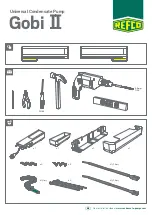
HE3XINH
Due to continuing product development, specifications are subject to change without notice.
© 2012 RenewAire LLC
134785_005 HE3XINHMan_Jan12.indd Revised 01/2012 www.renewaire.com
Page 5
Operation
Principal of Operation
The HE3XINH has one basic purpose: to exhaust air from a
structure and bring in fresh air from outside, while transferring
heating or cooling energy from the exhaust air to the fresh air.
The HE3XINH is a very simple device, and will accomplish this
purpose as long as the blowers for both airstreams are able to
move air through the energy-exchange core.
Checking that Unit is Operating
Airflow
Airflow should be occurring in both airstreams. Sometimes the easiest
place to confirm that air is moving is at the external wall caps.
If exact airflow is critical, it may be desirable to permanently
install flow measuring stations and manometers. These also can be
used to determine when filters should be cleaned or changed.
Use Static Taps in Doors to Measure Airflow Rates
See “Cross-Core Static Drop” in MEASURING AIRFLOW table. These
may be used to directly measure airflow in the unit.
Energy Exchange
Precise determination of installed sensible energy exchange
effectiveness requires careful measurement of temperatures and
airflows in all four airstreams, and in practice is somewhat difficult.
It is possible to confirm that energy is being exchanged simply by
feeling the ducts. If the Fresh Air duct from the unit into the room
is closer to room temperature than to the outside temperature,
energy is being recovered.
Operating Controls
A wide variety of control schemes may be selected by the
engineer, installer, or owner to meet the ventilation needs of
the facility. These may include timer clocks, occupancy sensors,
dehumidistats (for cool-weather operation), carbon dioxide
sensors, and others. DDC systems may also control the unit with
external control by other. Most control schemes will operate the
unit only when needed.
HE3XINH Airflow Performance
Motor
HP
Blower
RPM
Turns
Open
External Static Pressure (in. w.g.)
0.00
0.25
0.50
0.75
1.00
1.25
1.50
SCFM
BHP
SCFM
BHP
SCFM
BHP
SCFM
BHP
SCFM
BHP
SCFM
BHP
SCFM
BHP
2
1189
4
2185
1.0
2095
0.9
1900
0.8
1580
0.6
800
0.4
1329
2
2440
1.4
2360
1.3
2220
1.2
2020
1.0
1640
0.8
850
0.4
1470
0
2700
1.9
2640
1.8
2520
1.6
2360
1.5
2150
1.8
1770
1.0
1110
0.6
3
(a)
1496
3
2905
2.4
2815
2.3
2675
2.1
2505
1.9
2340
1.8
2220
1.6
1655
1.2
1560
2
3030
2.7
2945
2.6
2825
2.5
2655
2.3
2445
2.1
2325
1.9
1990
1.6
1656
0.5
3040
3.0
2875
2.8
2720
2.6
2575
2.4
2380
2.2
1688
0
2950
2.9
2800
2.8
2650
2.6
2490
3.0
5
(b)
1686
3
3300
3.5
3225
3.4
3015
3.2
2855
3.0
2800
2.8
2645
2.6
2470
2.4
1764
1.5
3290
3.8
3145
3.5
2995
3.3
2850
3.1
2705
2.9
1843
0
3300
4.1
3175
3.8
3040
3.6
2900
3.4
(a) Sheaves for 3HP motors can be adjusted from 1688 RPMs at 0 turns to 1400 RPM at 4.5 turns. Operating range shown is best for motor efficiency.
(b) Sheaves for 5HP motors can be adjusted from 1843 RPMs at 0 turns to 1503 RPM at 6.5 turns. However, motor efficiency drops at lower loads.
Continuous Operation
Continuous operation is acceptable in virtually all conditions.
Unit will not be damaged by continuous operation as long as
air flow occurs. Blower motors may overheat if filters become
completely blocked due to lack of maintenance. Motors are
thermally protected. With continuous operation, some external
frosting may occur in very cold weather (see below).
Operation in Extreme Cold Weather
Unit is capable of operating at outside temperatures down to
-10°F, with indoor humidities below 40%, without any internal
frosting. Unit can operate at more severe conditions occasionally
with little or no impact on its performance. At lower humidities,
it can operate at lower outside temperatures without freezing
the energy-exchange core.
Some condensation or even frost may form on the outside or
drip off of the case during very cold conditions, particularly if
the unit runs continuously. Exterior condensation during extreme
conditions can be reduced or prevented by periodically cycling
the unit off for several minutes to allow the case to warm up.






























